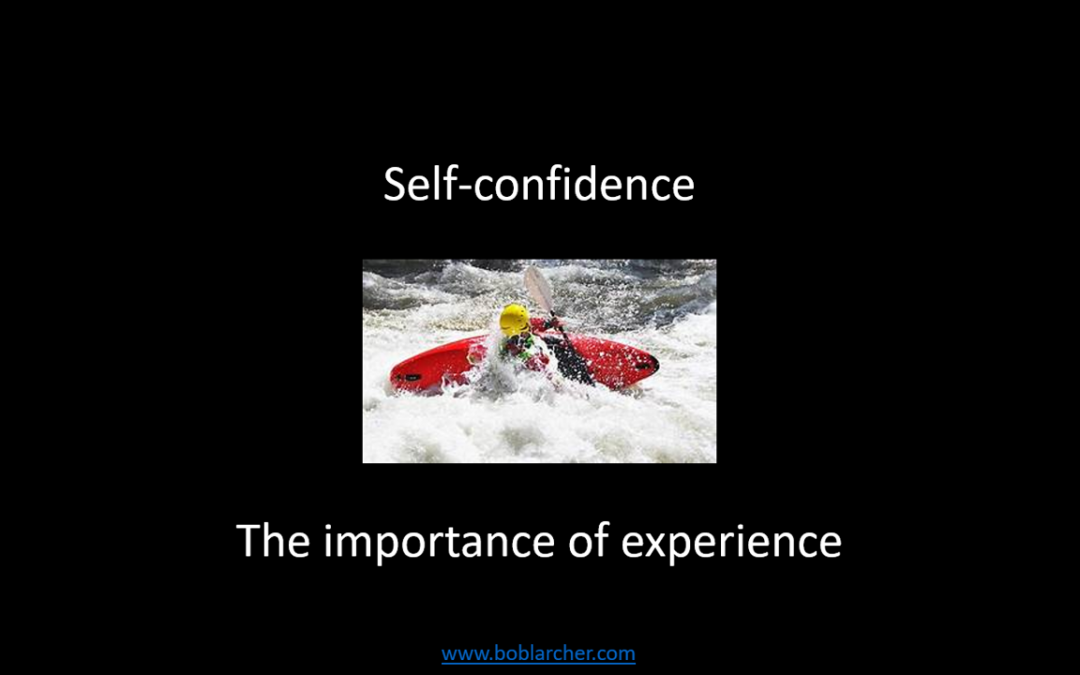While a “fake it ’til you make it” attitude is useful in certain situations, I’m not sure that in the long term that it is actually that beneficial.
Real self-confidence comes from experience and training; it’s through trial & error and continuous repetition that you gain confidence – the old “practice makes perfect” is true, and we (and our brain) learn from practicing new movements, new postures and new behaviours.
When I first started kayaking many years ago, one of the first things I did was to learn how to “Eskimo roll”.
I learned in a swimming pool, with people standing in the water around me, just in case ….. Clearly, I didn’t “roll-up” the first time; it took quite a few attempts, but in the clear & warmish water of the pool and with a diving mask to see what was going on, it wasn’t “too” difficult.
Once I had mastered the swimming pool I moved on to a local lake, not so clear and not so warm, but I was able to transfer my learning to a more “normal” situation.
Next step was a river; not too fast moving and not too many rocks.
By this time, my rolling “routine” was in my head:
Decide to capsize
Place the paddle, ready to roll up
Count to three
Capsize up stream
Roll up downstream
Smile triumphantly
Great, I had it cracked
Of course, when you are on a fast-moving river, it’s not exactly the same. Firstly, you do not “decide” to capsize, it happens when you are least expecting it; secondly, the paddle is not in “roll-up” position it’s in a paddling position and thirdly by the time you have counted to three it’s time to pull off the spray-deck and swim.
Not only that, but finding “downstream” when water is rushing past, you are banging your head on rocks, and the kayak is turning in circles is not obvious.
And after all that, the “smile triumphantly” is replaced by a look of embarrassment as your mates have to come and pull you out of the water.
However, with experience (both good and bad), I was able to master the art of “rolling up”; in fact, I became so good that I was nicknamed “the roller”; this was fortunate as it made up for my lack of technique.
This same learning process applies to many everyday situations, making a presentation, giving someone some difficult feedback, trying to keep a meeting on track, standing up to someone shouting you down etc. (and there is a lot of etc.).
The first step, is learning to do it in a “safe” environment, somewhere where you won’t end up caught between “a rock and a hard place”
Once you are confident in your safe environment, you need to get slightly out of your comfort zone and take some risks; these should be “calculated” risks – something that will be uncomfortable, but “doable”.
When you get to this point, it’s time to throw yourself into the rapids and learn to navigate the unexpected; learn from both what works and what doesn’t work – when I was upside in the rapids, I learned that the technique I had learned in “still” water had to be adapted to “turbulent” water, persisting with my still water technique meant swimming – which is not a pleasant experience in deep-sided, rock infested river gorges.
According to neuroscientists, we need to practice something “a lot” before it becomes integrated and fairly spontaneous – so don’t give up, too early.
Practice, get feedback, refine your approach, and practice again; for somewhere between 20 and hundreds of hours, this is hard to do; however, learning something new means being clumsy at it initially, making mistakes, feeling embarassed, correcting yourself, and trying again. It’s an uncomfortable process; even when we know the skill is valuable, many people stop trying new things and revert back to old habits – you need to get through the “no pain, no gain” barrier to start seeing the benefits.
The highpoint of my kayaking period was rolling my way down the gorges de la Pierre-Lys on the river Aude in France, a grade 4/5 river used in the French kayaking championships – I lost count of the number of rolls I made to get there, but there were a lot!!
Never forget the importance of the 3 P’s; practice, practice ………. and, yet more practice

I help people to develop their interpersonal skills, usually within a leadership or teamwork context. If you are looking to develop your leadership, I might be able to help. I’ve been doing this for almost 40 years; roughly four thousand days of seminars, workshops, conferences, coaching, offsites, webinars, etc. – put back-to-back that makes almost ten “full” years.



